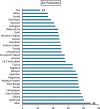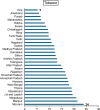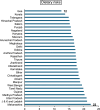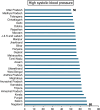Analyzing stroke burden and risk factors in India using data from the Global Burden of Disease Study
- PMID: 39349946
- PMCID: PMC11443044
- DOI: 10.1038/s41598-024-72551-4
Analyzing stroke burden and risk factors in India using data from the Global Burden of Disease Study
Abstract
Stroke remains a critical global health issue, significantly impacting India with substantial contributions to mortality and disability. This study comprehensively analyses stroke incidence, mortality, and disability-adjusted life years (DALYs) across India from 1990 to 2021, using the latest Global Burden of Disease (GBD) 2021 data. We evaluate how Universal Health Coverage (UHC), health expenditure, human development index (HDI), and gross national income (GNI) influence stroke outcomes. Our findings reveal significant regional disparities, with higher stroke rates in urban areas and states like Goa and Kerala. Higher health expenditure and HDI are linked to lower stroke rates, while higher GNI per capita correlates with increased stroke incidence, likely due to lifestyle changes. Risk factors include air pollution, tobacco use, dietary risks, and high blood pressure. Air pollution notably impacts stroke mortality in Bihar and Jharkhand, while tobacco use is a major risk factor in Mizoram and Manipur. Dietary risks and hypertension are prevalent in Maharashtra and Jammu & Kashmir. The study highlights the need for targeted public health strategies addressing regional disparities and socioeconomic factors. Policymakers should focus on lifestyle modification programs, public awareness campaigns, and enhanced access to quality stroke care to reduce stroke-related morbidity and mortality effectively.
Keywords: Global burden of disease; Regional disparities; Risk factors; Stroke burden; Universal health coverage.
© 2024. The Author(s).
Conflict of interest statement
The authors declare no competing interests.
Figures











References
-
- World Health Organization. The Top 10 Causes of Death. https://www.who.int/news-room/fact-sheets/detail/the-top-10-causes-of-death (2020).
-
- Feigin, V. L., Norrving, B. & Mensah, G. A. Global burden of stroke. Circ. Res.120, 439–448 (2017). - PubMed
-
- India State-Level Disease Burden Initiative Stroke Collaborators. The burden of stroke in India: A systematic review of population-based studies. Lancet Glob. Health6, e662–e671 (2018).
MeSH terms
LinkOut - more resources
Full Text Sources
Medical

